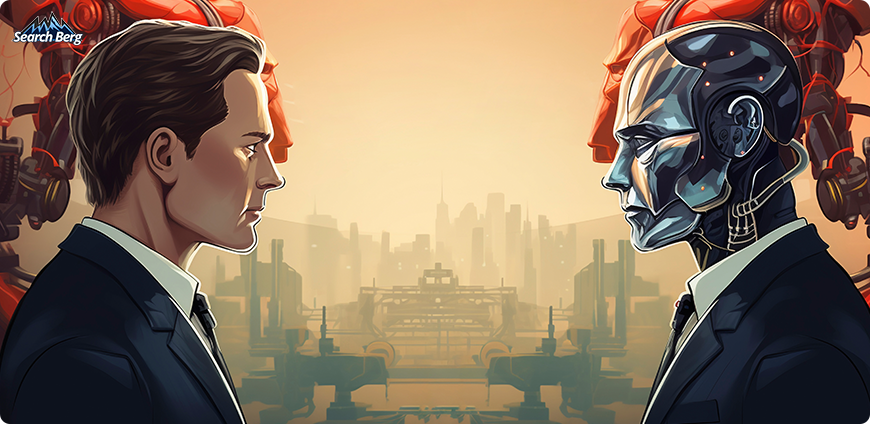Man vs. Machine: Battle Between Human Wit and AI-Generated Content
Highlights
- Poorly supervised AI-generated content faces problems.
- AI lacks emotional intelligence, experience, and perspective.
- AI-generated content lacks the depth of human-generated content.
- Concerns are raised about biases and inaccuracies in AI content.
There’s nothing wrong with putting out AI-generated content; it’s when this content is poorly written, minimally edited, and not fact-checked by an industry specialist that things tend to get ugly. The problem is further compounded by the fact that it’s becoming increasingly hard to tell human and AI content apart.
While OpenAI did introduce a “classifier” approximately a year ago, they were forced to shut it down shortly after a professor used it to grade papers. Long story short: They ended up failing the entire class, proving the classifier was more of a false accuser that sees everything as AI.
It’s a slight tangent, proving that artificial intelligence tends to hallucinate. It tells a half-decent story only to then describe an NBA player as “useless” when it’s tasked to write their obituary, of all things.
All to say: You can’t make this stuff up. (But AI can!).
Human vs. AI: The E-E-A-T Difference
Artificial intelligence lacks emotional intelligence and experience; it doesn’t have the perspective that humans do. AI can only generate what it has learned, meaning it is far from meeting the E-E-A-T (Experience, Expertise, Authoritativeness, and Trustworthiness) guidelines.
AI content appears skin-deep when it comes to churning out articles, blog posts, and anything that’s supposed to help an audience. Sure, it contains some fun facts, but the reader will feel it’s missing first-hand experience.
The Problem with “Buzzy”
Good writing is transformative; AI-generated content doesn’t have this. Just read one of the 44 articles “written” by Buzzy, Buzzfeed’s shiny new toy AI writing tool.
The Charleston travel guide, for instance, looks pretty. It even paints an impression of the city in our mind, but it does not mention specific tourist sites. We can find all the things it does mention within a five-mile radius. Why go all the way to South Carolina?!
You cannot make travel plans with a guide that was regurgitated by AI and edited by people who weren’t even on Buzzfeed’s editorial staff.
Google will allow it, though, but only if:
- It lives on a high-ranking site like Buzzfeed.
- It has a human’s extensive input.
AI Content: More of the Same
When it comes to content generation, there are only so many points AI can make—so many words it can use—before it starts repeating itself. You can forget about flair and personality; your AI-generated content will be homogenous and lack diversity.
This is because AI algorithms are trained on extensive, homogeneous datasets. When the datasets utilized for AI training lack diversity, it will reflect in the resulting algorithms.
You can come back to Buzzy for that. The writing tool has generated recurring phrases across numerous articles. It has prefaced a rhetorical question about a particular location with the familiar opener, “Now, I know what you’re thinking,” on multiple occasions.
Additionally, it heavily favors the expression “hidden gem,” using it extensively in nearly all of its content.
AI to Humans: Challenging Stereotypes is So 2020 (Let’s Learn ‘em!)
Biases and inaccuracies are imminent with algorithms taught homogenous datasets. There is no shortage of misinformation in AI-generated content.
Here are two for reference.
Let’s start with Men’s Journal’s first foray into AI content. At first glance, the article “What All Men Should Know About Low Testosterone” sounds like a human wrote it and seems as authoritative as Google wants it to be. However, it contains approximately 18 factual errors, which were pointed out by the chief of medicine at the University of Washington Medical Center.
Then we have CNET, which faced scrutiny after discreetly releasing a series of AI-generated articles containing factual inaccuracies and instances of apparent plagiarism. At the time of writing this, the online publication has issued corrections for 41 out of the 77 news stories.
Google’s Take on AI-Generated Content
Google is all for AI content as long as it’s high-quality, helpful to the target audience, and not used deliberately to rank higher. These requirements can be pretty abstract, which is where we come in.
Avoid the drawbacks of AI content and create the content your audience and, by extension, the search engines want to see by entrusting our humans with content creation.















